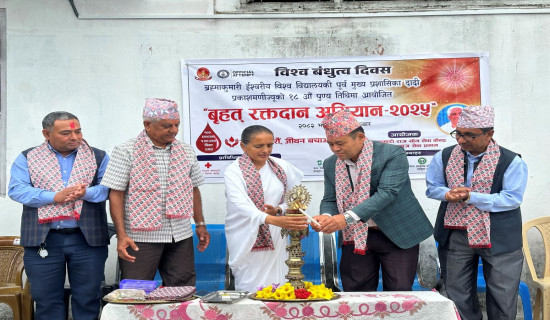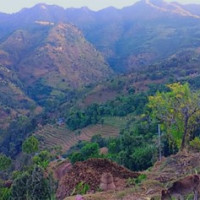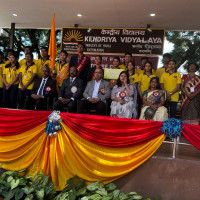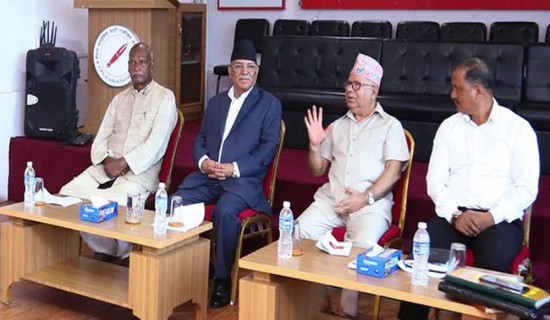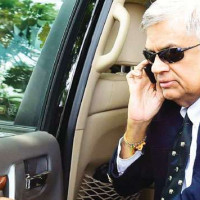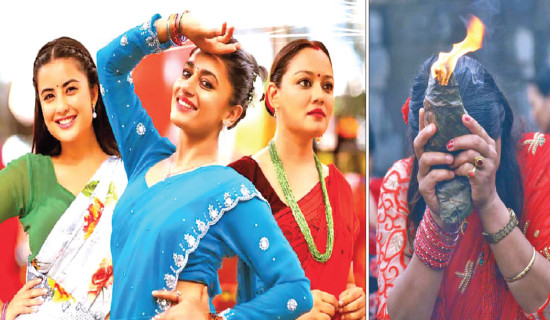- Saturday, 23 August 2025
Sports Sector Needs Radical Revamp
The status of sports in Nepal leaves much to be desired; however, the country is gradually making its presence felt in the international sports arena. The country is now somewhat recognised in the international field for such sports as cricket, swimming, football, volleyball, boxing, wrestling, archery and martial arts. Nepal’s international outing in sports began in 1951 when it participated in the Asian Games held in New Delhi. The country has participated in the Olympic Games since 1964, except in the Mexican Olympics in 1968. By participating in Olympics, Asiad and other sports, the country has won some medals but has nothing to show for it. This shows that the country has a long way to go as far as making it big in international sports is concerned.
Nepal won the gold medal in football in the South Asian Games in 2016. During the Olympic Games held in the same year, Gaurika Singh represented the Rio Olympics as the youngest athlete, a matter of glory for the country. In women’s football, Sabita Bhandari is a name to reckon with. She now plays for the French women’s first division club EV Avant-Guingamp. The country bagged the ICC Digital Fan Engagement of the Year in 2023, an award that is testimony to the country’s improving performance in cricket.
Unity
Sports are not just games; they are multidimensional in nature. Sports know no boundaries. They serve to boost cultural exchanges between nations and instil a feeling of unity, solidarity and synergy into the minds of people. In a world characterised by strife, sports can bring even warring countries together and help bring about rapprochement between them. Sports can be used as a diplomatic tool for peace, détente and rapprochement. During the 1970s, China and the USA used ping-pong (table tennis) diplomacy to improve their strained bilateral relations. Further, sports can boost tourism, create job opportunities and contribute to stimulating the economy. For example, Qatar organised the FIFA World Cup in 2022 and earned USD 2.3 to 4.1 billion from tourism and World Cup-related broadcasting.
There are sports leagues around the world. The National Basketball (USA), Major League Baseball (USA), English Premier League (UK), La Liga (Spain), Bundesliga (Germany), Indian Premier League (India), Serie A (Italy) and UEFPA Champions League (Europe) are among the major leagues in the world. In Nepal, there are the Nepal Super League, Nepal Premier League, Everest Premier League, Nepal T20 League and Nepal National League, among others.
Nepal is making efforts to improve the sports sector. However, the country lacks sports infrastructure and facilities. That the Dasharath Stadium is not fit for hosting international football has a deep meaning for the government, prodding it to pay heed to constructing international-level stadiums not only in the capital city but also in other major cities. Further, there is a need to develop more sports academies. Such academies should be equipped with state-of-the-art technology, advanced training equipment and quality coaching. Coaches may be hired from around the world.
The government should pay attention to skills development in players. Those who are interested in sports should be trained year-round under highly competent coaches. Their talent should be recognised. Such aspiring players should be involved in sports only. The trend of training players just some time before the commencement of international sports should be ditched. When players are involved in sports only, they can concentrate on honing their professional skills. But for this, they should be provided with adequate remuneration so that they can live a decent life.
The budget allocated for the youth and sports sector for this fiscal year is Rs. 6.08 billion against the total budget of Rs. 1.96 trillion. This budget allocation is far higher than last year’s budget allocation of Rs. 3.5 billion. The government has planned to build an international-level stadium in Damak, Jhapa, build high-altitude stadiums in Solukhumbu and Mustang, upgrade the TU International Cricket Ground for Rs. 400 million and upgrade Mulpani, Fapla, Siddhartha and Girija Prasad Koirala Cricket Grounds at a cost of Rs. 420 million. This shows that the government is serious about developing sports.
League competitions
Regular league-level sports competitions hold the key to developing sports. So, such competitions should be organised all year round for the development of sports. We can draw lessons from European football, where such sports competitions are held all year round. European football teams are among the world’s top teams. Holding league competitions regularly will help players build self-confidence, sharpen their skills and develop professionalism and sportsmanship. Participating in international sports will help them gain international exposure. And making it big in international sports will certainly boost the country’s image.
In the present-day context, Nepal sends very few players to international sports such as Olympics and the Asiad Games. And the players return home with one or two medals, sometimes with none. What is worrying is that an unhealthy tendency has developed in the sports sector: an unnecessarily large number of sports officials accompany players to hosting countries. The number of such officials often exceeds that of players. Their visit is often termed a junket. Such a tendency must come to an end.
It may be noted that the FIFA World Cup is perhaps the most popular sports event in the world. Every country desires to play in the event. Nepal has not been able to grab an opportunity to participate in the event. For the country, participating in the event is a far cry as it has not been able to even qualify for the event. So the government should pay assiduous attention to the development of sports by building adequate sports infrastructure, facilities and academies and by creating an appropriate environment for players to be trained and develop their professional skills.
(Maharjan has been regularly writing on contemporary issues for this daily since 2000.)



